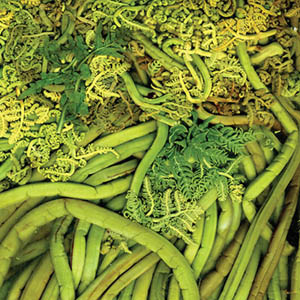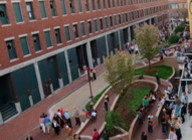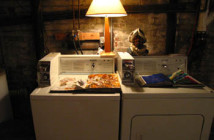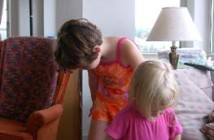It would be hard to have missed the recent proliferation of digital photography. It’s even at WalMart. Inevitably there has been an equally large upsurge in the number of crappy digital photographs, but there are also a significant number of artists who are turning away from traditional 35mm or even large format photography to work with a digital camera, computer, and inkjet printer. Part of the allure of photography has always been the darkroom, and now that’s being passed over in favor of a well-lit, toxic chemical-free home office space. WTF? Color by Digital at Artspace@16 aims to show us, colorfully, why digital?
For those working in assemblage or collage the digital medium provides an opportunity to create seamless images out of random ones and to create layered compositions. The artist is allowed a high degree of freedom and accuracy. Objects can be resized, reversed and perfectly placed to create a complete and perfectly weird world. Nadine Boughton’s collages cartoon images of food and people in bizarre pop-art situations; Leah Oates takes a photograph of a field and crops it to the shape of a woman; Tomislava Franicevic layers text and pattern over image in slick compositions reminiscent of advertising. The use of layers supplies, quite literally, layers of meaning and mimics the technical process of working in Photoshop. Where layering was once only possible using multiple exposures, it’s now easy and infinitely controllable.
The flexibility of the digital image is remarkable. Fred Levy’s creepy portraits make the most of it, and of Photoshop’s toolbox. Eyes are enlarged; chins twisted; noses distorted and pulled apart: they could be Francis Bacon paintings, but because they are photographs we think twice about whether they’re real. Michael Jewell’s black and white print of four men walking is made of two images merged and it takes a couple looks to realize that the four men are two men, twice.
Many of the works push in similarly subtle ways. Milos Toth’s photos are normal, but unsettlingly sharp and vivid. Isabel Seliger breaks her images down all the way to the pixel level, microscope-like, reveals the beauty of the technology itself. Patric Shurden obscures his image with drawing and painting, then obscures the drawing and painting by re-digitizing.
Some use digital to get away from traditional printing as much as possible – Sandra Salamony’s photo/scans on paper and encaustic feel like a game of Find the Photograph. Michael Jewell layers images on vellum and the texture of the paper and properties of the ink have a far stronger presence than whatever the photo was. The digital/inkjet allows departure from the rigid strictures of photo chemicals and papers. You can print on anything that won’t break your printer (unless that’s what you’re going for, as does Ryan Cheney, who abuses his printer until it overheats and burns his image – in just the right way, of course).
Several artists even kick the camera to the curb and scan the objects directly. Toru Nakanishi’s Chinese beans, Lynn Wiles’ orchids and Joan McCandlish’s otherworldly potato point to new possibility in photographic still life. The detail in a high-resolution scan almost puts an 8x10 to shame.
Nakanishi, who is curator as well as exhibiting artist, devotes special attention to those attempting to print in black and white, which has traditionally been somewhat of a nightmare. Several works, including his own, demonstrate mastery of the technique. Hopefully, given the recent introduction of the Piezo seven color grey-scale printer, it won’t be such a challenge in the future.
Many of the photographs including the landscapes of Micheal Cirelli and the images of dancers by Cristina Pujol are so traditional in their composition and printing that one might wonder why they chose to work digitally. The truth is that digital photography is accessible. It’s easier to learn the basics of Photoshop than to make a good C-print in the darkroom – and that’s assuming you have access to a good color darkroom, which you probably don’t. It might be more appropriate, then, to ask “Why not digital?” Now that the technology is good enough, there really is no reason.
Photography is always inextricably tied to the technology because that is its material. It’s like trying to talk about a painting without talking about paint. The extra bind in photo is that the thing itself (what you photograph) is equally inescapable. Representation often becomes a coy game to obscure and build levels of complexity into the image. Film photographers have found ways, but their options are slim compared to the raw material offered by a digital image. Add a computer and a printer and suddenly you’ve got a lot of control.
Unlike most photography shows, works’ inclusion in Color by Digital is not just about their good composition or their well-developed theme: it’s about their use of the technology. Any reading of the show must be based on those terms: the image, the process, and the equipment used to execute them. I couldn’t help but notice the number of photographs of water – ponds, streams, reflections – and I can’t help but wonder at their apparent lightness and transparency, as if they’re grasping for something ethereal with a hulking machine.
Links:
ArtSPACE@16
"Color by Digital" was on view at ArtSPACE@16.
All images are courtesy of ArtSPACE@16 and the artists.




